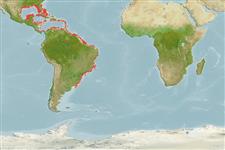Klassifizierung / Names
Namen | Synonyme | Catalog of Fishes (gen., sp.) | ITIS | CoL | WoRMS | Cloffa
Actinopterygii (Strahlenflosser) >
Clupeiformes (Herrings) >
Clupeidae (Herrings, shads, sardines, menhadens) > Dorosomatinae
Etymology: Sardinella: Latin and Greek, sarda = sardine; name related to the island of Sardinia; diminutive (Ref. 45335).
Lebensraum / Klimazone / Range
Ökologie
; seewasser; brackwasser; ozeanodrom; tiefenbereich 5 - 60 m (Ref. 114041). Subtropical, preferred 26°C (Ref. 107945); 31°N - 36°S, 98°W - 35°W
Western Atlantic: Gulf of Mexico, Caribbean, West Indies southward to Brazil and northern Uruguay (identifications are not always reliable).
Length at first maturity / Size / Gewicht / Alter
Maturity: Lm 19.2 range ? - ? cm
Max length : 27.0 cm TL Männchen/unbestimmt; (Ref. 103182); common length : 20.0 cm SL Männchen/unbestimmt; (Ref. 188)
Rückenflossenstacheln (insgesamt): 0; Rückenflossenweichstrahlen (insgesamt): 13-21; Afterflossenstacheln 0; Afterflossenweichstrahlen: 12 - 23. Diagnostic features as for Sardinella aurita from which it differs in having the anterior gill rakers on the lower limbs of the second and third gill arches distinctly curled downward (more or less flat in S. aurita) (Ref. 188). The pelvic fin ray count of i 8 distinguishes S. brasiliensis from all other species of Sardinella, also Harengula and Opisthonema (Ref. 188). Similar to S. aurita (Ref. 26938). Bluish black above. Peritoneum black (Ref. 37032). Separation of Sardinella brasiliensis (synonym of Sardinella janeiro) from Sardinella aurita on the basis of gill raker shape and a higher gill raker count is tentative.
Found in coastal waters, often forming compact schools. Maximum depth range based on spawners in Brazil (Ref. 114041). Probably similar to S. aurita, but if they are indeed distinct, then this species may account for the double spawning peaks of S. aurita. Constitutes a large fishery in Venezuela, but statistical reports are not separated from S. aurita. Marketed fresh and canned (Ref. 5217).
Whitehead, P.J.P., 1985. FAO Species Catalogue. Vol. 7. Clupeoid fishes of the world (suborder Clupeioidei). An annotated and illustrated catalogue of the herrings, sardines, pilchards, sprats, shads, anchovies and wolf-herrings. FAO Fish. Synop. 125(7/1):1-303. Rome: FAO. (Ref. 188)
IUCN Rote Liste Status (Ref. 115185)
CITES (Ref. 94142)
Not Evaluated
Bedrohung für Menschen
Harmless
Nutzung durch Menschen
Fischereien: hoch kommerziell; Köder: usually
Mehr Information
ReferenzenAquakulturAquakultur ProfilZuchtlinienGenetikAllel-HäufigkeitenVererbbarkeitKrankheitenVerarbeitungMass conversion
PartnerBilderStamps, CoinsLauteCiguateraGeschwindigkeitSchwimmstilKiemenoberflächeOtolithsGehirngrößeSehfähigkeit
Tools
Zusatzinformationen
Download XML
Internet Quellen
